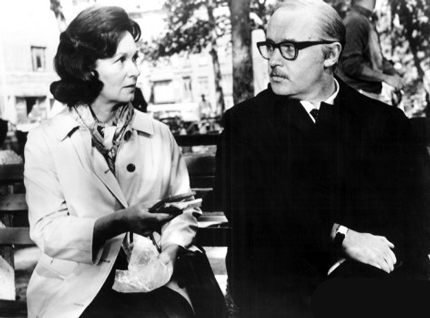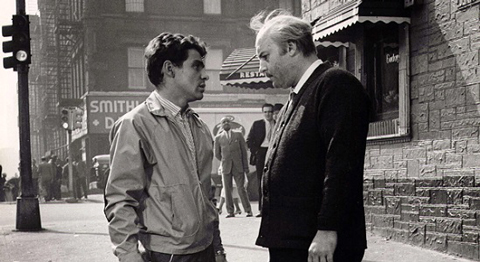Reviewed by Glenn Erickson
In 1964 filmic dramatizations of the Holocaust had been limited mostly to European and Soviet bloc productions. American disinterest and the difficult nature of the subject had a dampening effect as well; not only was most of the truth about concentration camps and genocide not considered appropriate for filmed entertainment, any truthful treatment would have aspects that the Production Code would nix.
That's why Sidney Lumet's The Pawnbroker came as such big news. It probably broke no box office records, even as art film, yet almost everyone heard about it. It was syndicated on television before 1970, albeit with a little cutting and bleeping of audio that surely dulled its central trauma. Now Olive films presents this quality independent production in a beautiful transfer at a proper aspect ratio. The film plays better than ever. It has sensational performances, excellent photography and a terrific early music score by Quincy Jones.

Middle-aged Sol Nazerman (Rod Steiger) is emotionally handicapped. Since losing his family and beloved wife in the war he's been unable to express, or even 'feel', his own feelings. Cut off from normal human activity, he lives joylessly with the wife of a dead friend. He also supports his sister in-law's family. Sol runs a pawnshop in Spanish Harlem, where he deals coldly with a parade of pathetic customers, that include drug addicts thieves trying to sell stolen merchandise. He refuses to interact with anyone on a personal level, which hurts the feelings of a gabby old man (Juano Hernandez) who drops by in search of conversation. Nazerman's rejection also offends Marilyn Birchfield (Geraldine Fitzgerald), a social worker trying to raise money for disadvantaged neighborhood kids. Sol's assistant is Puerto Rican Jesús Ortiz (Jaime Sánchez), a good natured but naive fellow who cannot fathom his boss's cold and cruel behavior. Sol undergoes a crisis of conscience when he can no longer deny that his business backer Rodriguez (Brock Peters) is using the unprofitable pawnshop as a front to launder money for his rackets, such as a brothel. Jesús reacts to Sol's hurtful words by conspiring with the local gangster Tangee (Raymond St. Jacques) to rob the pawnshop. But Sol's depression is such that he invites both Rodriguez and Tangee to kill him.
"Where'd you get that number on your arm? Do you belong to a club?"
Sidney Lumet's The Pawnbroker examines the Holocaust's effect on a traumatized survivor through psychological means. Twenty years after the horror, Sol Nazerman lives in a place where nobody knows what he went through. He's a mentally sick man, haunted by memories of what happened to his children and his wife. The social worker Marilyn sees his conflict but cannot cut through the scar tissue. Although some scenes in The Pawnbroker have a strong theatrical charge, there is no uplifting personal breakthrough for Sol. He can barely express the horror he's been through. He rebuffs Marilyn's attempts to talk personally, and later when he's compelled to look her up, the few words he says chill her to the bone. Marilyn reaches her hand out but Sol is beyond compassionate therapy. Can some kind of catharsis bring him back to the world of the living?

The Pawnbroker made movie news with its method of presenting flashbacks to Sol's ordeal in a concentration camp. The (then) radical editorial approach made a name for editor Ralph Rosenblum, who started with Robert Flaherty's classic Louisiana Story and went on to cut many important pictures for director Lumet. He also helped Woody Allen evolve his style. For The Pawnbroker Rosenblum uses two- and three-frame flash cuts to represent the horrible memories that haunt Sol Nazerman. A couple of random, semi-subliminal flash cuts intrude in early scenes. Later, specific visual stimuli trigger more flash cuts, and then slightly longer memory images from concentration camp horrors. The effect is of a nagging memory crashing bit by bit into the conscious present.
Sol passes some thugs beating up one of their own, and is nauseated by the memory of camp guards turning an attack dog loose on a helpless prisoner. A customer pawns a framed display of butterflies, which causes Sol to recall an idealized happy day playing with his family, before their arrest by Nazis. This pattern has been grossly overused since 1964. Associative flashbacks of this kind, sometimes with similar flash-cuts, are a common device to provide instant character exposition without dialogue.
Sol's central horror becomes clear in a scene that could easily have become exploitative if it were not for Lumet's responsible direction and his dedicated actors. Jesús Ortiz' black girlfriend (Thelma Oliver) is a prostitute in one of Rodriguez's houses. Fearing that Ortiz will do something illegal, she corners Sol behind the pawnshop counter and offers him sex for money. To entice Sol she bares her breasts, but the sight instead triggers his most dreaded memory, when he saw his wife and other prisoners being raped by German officers. The cutting here is precise, and follows a believable stimulus/reaction pattern: every time Sol looks up, he sees not the naked woman before him but instead his lost wife, waiting helplessly to be violated.
Progressive film critics jumped on this scene as evidence that the movies needed to be free of the Production Code, and even the censors did not doubt that here was one film with blatant nudity that was wholly legitimate and justifiable. Playboy magazine presented a still of the scene with the argument that the movies were becoming more liberated. The Catholic Legion of Decency still condemned The Pawnbroker on the basis that it would encourage other, more exploitative displays of nudity under the smokescreen of redeeming social content. Other church-oriented censorship advocacy groups disagreed, however. The Pawnbroker received a Production Code seal on appeal, as a noted exception. It wasn't widely released until April of 1965 because that Code Seal was still required by most exhibitors. 1

I've only seen a couple of Sidney Lumet films that didn't impress me, mainly because the acting in them is always so good. The character of Sol Nazerman sounds like a ripe opportunity for Rod Steiger to overact, but his is a beautifully modulated performance. Sol is not a noble victim; his experiences have made him a deeply troubled human being. The underused Geraldine Fitzgerald is appealing, but also not a liberal super-woman. Young Jaime Sánchez (The Wild Bunch) displays both spirit and poor judgment as Jesús, foolishly telling Tangee about the extra cash Nazerman has in his safe.
Steiger's powerful performance is matched by the honesty of Thelma Oliver, and the menace represented by Brock Peters and Raymond St. Jacques. Juano Hernandez is heartbreaking as a lonely soul who just wants somebody to talk to. Sidney Lumet's father Baruch Lumet plays an invalid relative who hates and criticizes Sol. Reni Santoni (Clint Eastwood's partner in Dirty Harry) has a riveting couple of bits as a junkie desperately trying to pawn a worthless radio.
Not harming the film but pushing it slightly over the line toward pretension are events that set up Sol Nazerman as a Christ-like martyr. The pain Sol inflicts upon himself is open to interpretation. Is he expressing his profound sadness for Jesús Ortiz, or is he trying desperately to make himself feel something, through an extremely painful act?

Olive Films' Blu-ray of The Pawnbroker is licensed from Paramount Pictures. It was originally released by Allied Artists but moved over to American-International, whose logo appears at the end. The image is just sensational, with the B&W cinematography of Boris Kaufman looking outstanding. In addition to the fine widescreen HD transfer, somebody must have done some cleanup, for I saw no dirt or scratches. The audio is also in prime condition. Lumet makes the soundtrack go truly silent at times, just before dramatic dialogue lines. Quincy Jones music score has the expected fine jazz but also cues in a variety of styles, including one meant to imitate AM radio filler.
I'd never seen all of The Pawnbroker before and this Olive disc is an ideal presentation. It's especially good for studying the film's experimental editing style, but what held me were the very strong performances.
On a scale of Excellent, Good, Fair, and Poor,
The Pawnbroker Blu-ray rates:
Movie: Excellent
Video: Excellent +
Sound: Excellent
Audio: English and scene or two of Spanish
Supplements: none
Deaf and Hearing Impaired Friendly?
No; Subtitles: None
Packaging: Keep case
Reviewed: April 18, 2014
Footnote:
1. According to Richard S. Randall's book Censorship of the Movies, the only films approved by the Production Code Administration (PCA) yet condemned by the Catholic Legion of Decency were Son of Sinbad, Baby Doll, Kiss Me Stupid, The Pawnbroker and Hurry Sundown.
Although the issue isn't often acknowledged, I don't think the race factor can be ignored when discussing the film's nude scene. These are the breasts of a black woman on display here, and a pernicious double standard on that has always existed in American films.
When I saw parts of the film on television it was of course shown open-matte full frame. Some things had to be cut out, but quite a bit of the Thelma Oliver scene was left intact, only optically enlarged to remove the nudity.
Return

Text © Copyright 2014 Glenn Erickson
See more exclusive reviews on the Savant Main Page.
Reviews on the Savant main site have additional credits information and are often updated and annotated with footnotes, reader input and graphics.
Return to Top of Page
|

